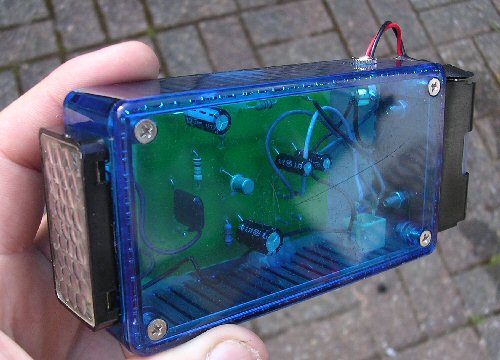Mini light beam receiver
Note: for details of talks and workshops on this topic click here:
talks and workshops
Click here for a light beam mini film

The handheld mini light beam receiver. On the left is a small solar cell, you can make out the various components on the circuit board through the transparent lid of the box. On the right, top and bottom, are the headphone and crystal earpiece sockets while the battery is just visible in its holder at the back (far right). I simply unplug the battery connector to turn the unit off.
Note I: this article compliments one already published and which is also on this web site see:
Voice on a light beam
Note II: This page is work-in-progress, so if you spot spelling mistakes or find you need more info. please e-mail me (go back to the CSC home page).
A very simple device to convert light into sound can be made by wiring a solar cell directly to headphones (or an earpiece). The solar cell converts light into electricity and the headphones convert electricity into sound. The limitation is that this set-up is very insensitive.
What follows is a far more sensitive circuit as it contains a transistor amplifier which provides about x100 amplification. The circuit must rate as the simplest starting point to effectively listen to light! We have made what is effectively a simple preamplifier stage which for example can go before a pair of computer speakers.

circuit diagram of the simple pre-amp cpable of driving stero headphones or a crystal earpiece
The circuit is capable of powering a crystal earpiece and (with some loss of volume) stereo walkman MP3 type headphones directly. As only the AC part of the signal goes through to the transistor it does not matter which way round you wire in the solar cell. So with just a handful of components and a battery you can start to re-explore the world with this little device - to hear what you have up to now only seen!

A very simple light beam transmitter can be made by glueing a small mirror onto the back of an empty tin can!
Some ideas for things to investigate with this device:
1) find a room with loud music playing (or orchestra playing) and when outside look out for sunlight reflected from one of the windows (or use torch / laser) and listen to the light - can you hear the orchestra on the light?!.
2) try the above from light reflected from car windows of a car playing loud music.
3) listen to the dappled light from trees or from the ever changing surface of the sea / lake. Try listening to light shinning through a fan / extractor or other rotating device.
4) use a prism to brake up sunlight into the rainbow of colours. Listen to the IR and UV parts as well as the visible parts of the light in these experiments.
5) experiment with a laser pointer. You might get greater distances but is the sound better quality or worse, why? Try reflecting off all sorts of objects ...
6) make use of mirrors, shaving mirrors, lenses and parabolic like surfaces (shells, plates bowls ...) to collect light.
7) connect solar cell to eye piece of telescope and start to listen to distant objects: terrestrial and astronomical.
8) if you use binoculars you can use one 'eye' for the photocell and one for you to look through - you know what you are looking at when you listening to it!
9) use a cutup transistor instead of photocell / solar cell (see first article). Power transistors are larger and may work better as a solar cell.
10) other ideas for reflective surfaces: foil, shinny wrapping paper, bottom of tin cans mica, v thin metal, plastic mirrors ...
11) listen to engine parts or other fast moving things; stick shinny tape to rotating axles and shinning a torch on it listen to reflected light.
12) can you hear a reflection from a record grove (fine laser beam light). What about light reflected from a turning cd, what does it sound like?
13) attach a mirror to a piezo buzzer (or polish up its metal surface). Do you get best signal when reflecting grazing incidence or when head on?
14) Listen to PWM (pulse width modulation) displays such as LED alarm clock displays, fruit machines, TV screens, data projectors.
15) Do mains electricity driven lights produce a 50 or 100 Hz signal (60 or 120 Hz USA)?
16) experiment sending light through optical fibres.
17) yellow glasses are used by cyclists and adventurers as they see through haze better than normal clear glasses or sun glasses (once the eyes have adjusted to the new light levels). What colour light is best to send a light beam signal?
18) hang up a large sheet of foil and listen to reflected light as wind moves these solar chimes.
19) try glueing a mirror to a balloon, hang it in a room full of people. Bounce light off mirror (sunlight) and 'listen' to it.
Dr Jonathan Hare, E-mail: jphcreativescience@gmail.com
NOTE: Although none of the experiments shown in this site represent a great hazard, neither the Creative Science Centre,
Jonathan Hare nor The University of Sussex can take responsiblity for your own experiments based on these web pages.
THE CREATIVE SCIENCE CENTRE
home | diary | whats on | CSC summary | latest news



